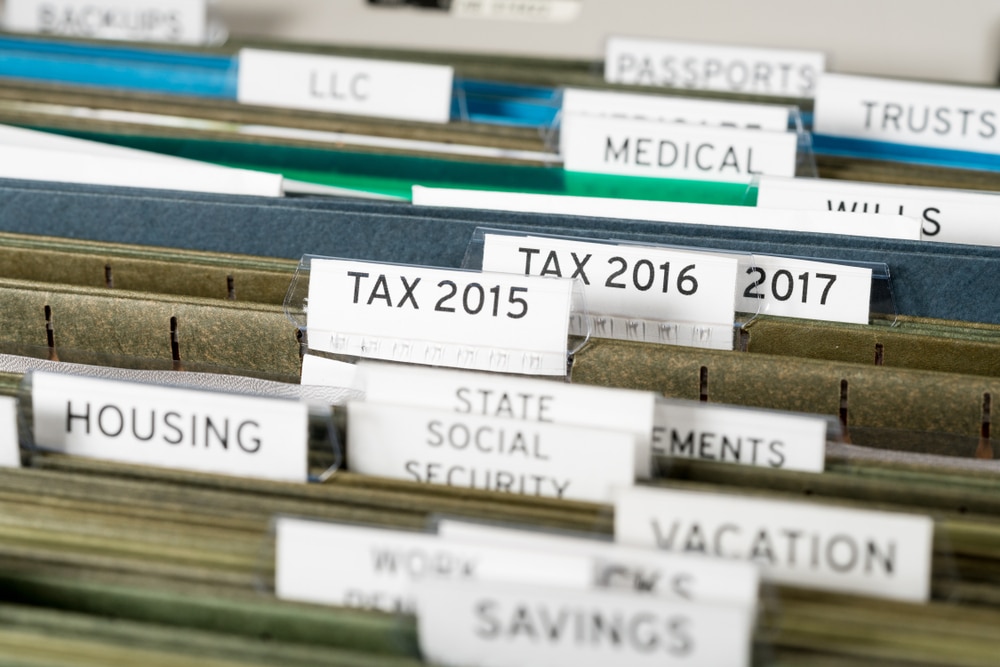How to Effectively Organize Your Tax Records

Ever notice how sometimes, the root of huge problems is the tiny details surrounding a particular situation? Because of their small size, we tend to brush them off as unimportant without fully realizing their value.
Take your tax records, for instance; by underestimating the importance of organizing your files and documents, you risk running into problems while preparing your tax return and also during an IRS audit.
Proper and timely filing of taxes can be a burden if you don’t have your records sorted out. In that case, you can’t expect the IRS to be on your side. That’s why you need to be responsible in this department.
The organization and filing tips in this article will help you handle your tax records so you don’t get burned.
1. Have accessible storage
First things first: you need a place to keep receipts, forms, and other types of paperwork in an easy-to-reach location.
You don’t want to go through the trouble of having to drag a chair or ladder to reach for your box storage every time because, then, you might decide to “safe-keep” the documents somewhere convenient until you’re less busy to do it. Eventually, you’ll forget about them, and by the time you try to retrieve them, you don’t know where to start looking.
By carefully picking where to keep your files, you can avoid putting things off.
2. Label everything
This step is pretty straightforward, and as earlier mentioned, it’s these little things that should not be ignored if you want to avoid hitting a wall organizing your tax records. Whether it’s a folder, an envelope, a caddy, or an online repository for your tax documents, they should be clearly labeled to help you tell one from another quickly and easily.
It’s up to you how you want to label things, but for tax records, it can be by year, source or department involved, company, expense type, etc. If you are an expat business owner, it can be by manufacturer, income and expenses, running capital, and many more.
You’ll be surprised at how this simple technique can save you a great deal of effort in making your tax filing responsibilities more manageable and less stressful.
3. Categorize your tax documents
Tax deductions have different classifications. They could range from income and personal property tax to medical expenses and childcare payments. To avoid confusion, it’s best to sort your papers based on their categories. This method of organizing your tax documents is a great way to determine all the types of deductions you can file on your tax return.
Besides the aforementioned tax deductions, you can also categorize your tax documents in several other ways.
- Charitable donations
- Real estate transactions (mortgage payments, home insurance, and the like)
- Property and sales tax payments
- Student loan payments
- Work-related expenditures not reimbursed by your company
- Self-employment expenses (purchase of office supplies, office cleaning, payments to contractors)
- Utility bills if you’re maintaining a home office
4. Review your tax filing in the previous years
Copies of your previous tax filings can form the basis of your future tax returns, where you’ll only need to update your information to make it current. This practice also makes computing for any amendments on your returns easier. That makes it important that you know how long to keep your tax records.
Among several other periods of limitations, the IRS recommends three years from the date you filed your return or two years from the date you paid the tax, whichever is later. That is if you need to claim a credit or refund after filing your return.
5. List down the necessary tax information
Filing tax forms need not be a tedious task if you know the types of information you should gather beforehand.
Besides your Social Security Number, you need to note those of your dependents since they are required when claiming deductions. Or, if you’re paying taxes on a property, you need to know the amount paid during the tax year. Just ensure that all of your information is accurate to save you from having to amend your returns later.
6. Prepare a checklist of your tax documents
A checklist can help you determine all the information, documents, and records you’ll need to file your taxes. Oftentimes, your tax professional will provide a checklist or tax organizer of information needed for the preparation of your tax return. It also lets you see if there are missing items that you still need to secure. Don’t forget to include when and where to accomplish each item for a more systematic preparation of your tax records.
Then, as you go through your checklist, mark things as they get done and then move on to the next one on the list until everything is well accounted for.
Take the Right Steps in Tax Preparation and Filing
Before you can prepare your tax return, you have to start with your tax records. It’s essential to take the necessary steps to keep your tax records organized so that you can avoid potential issues in your tax history.
If you’re unsure how to prepare your taxes, a tax resolution specialist from Tax Samaritan can be of great service. We’ll take care of putting together a tax plan that suits your situation and—equally important—meets IRS requirements. Get in touch with us to learn more about our service.

All About Randall Brody
Randall is the Founder of Tax Samaritan, a boutique firm specializing in the preparation of taxes and the resolution of tax problems for Americans living abroad, as well as the other unique tax issues that apply to taxpayers. Here, they help taxpayers save money on their tax returns.